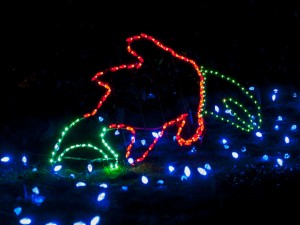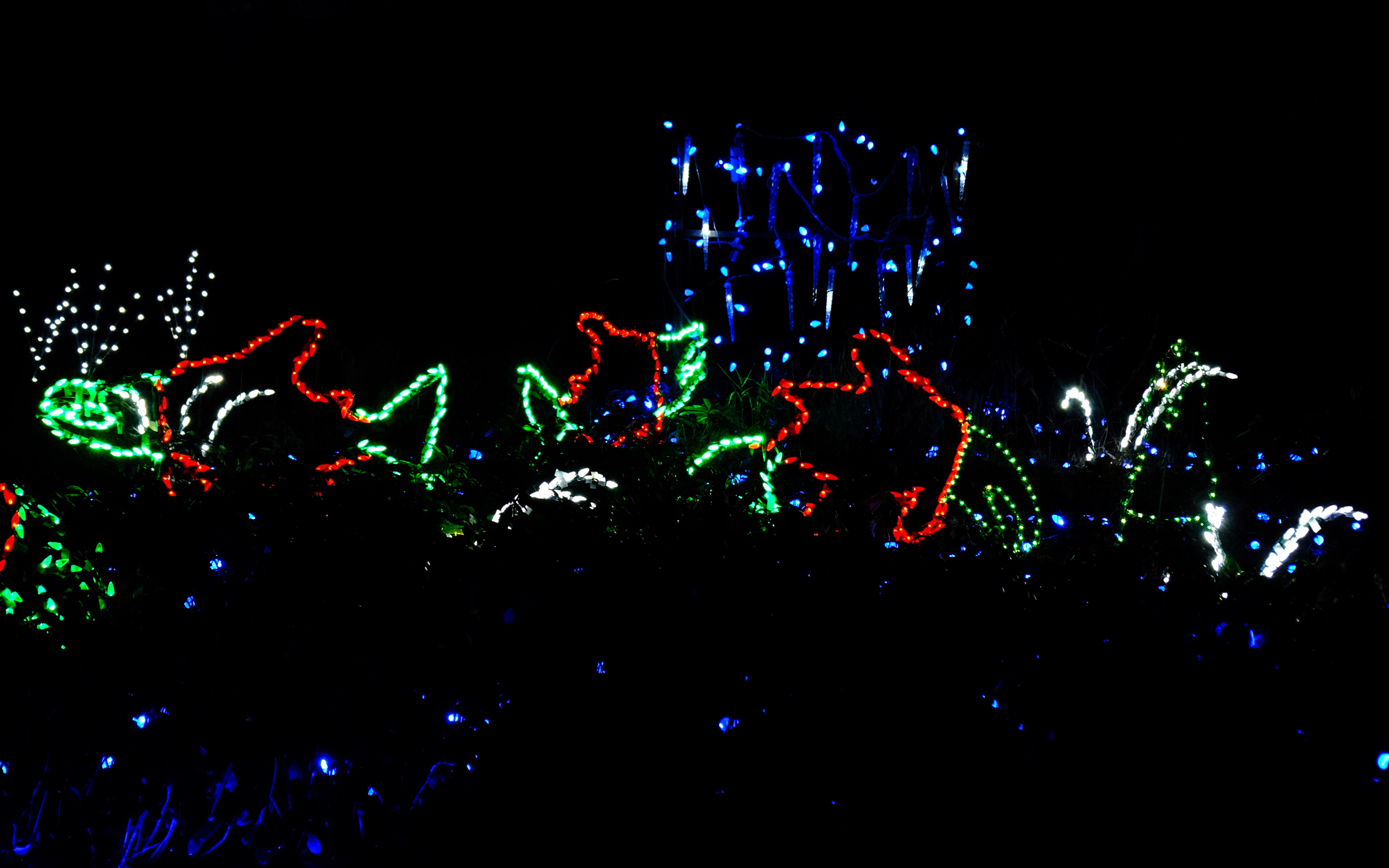December 8, 2025 — Welcome! The Sugar Plum Salmon, now in their second decade of dancing to the music, have brought some spectacular new friends with them this year.
What started as a small salmon going upriver display has grown into something much bigger—the salmon now share the spotlight with an ever-expanding cast of lights and effects. This year’s stars are two massive Showstopper Spinners flanking our main matrix display, plus two vertical matrices lighting up the second story.
The fairy/angel wings have returned (fingers crossed they behave better than last year!). While they normally sync with the music like everything else, we’ve added something special: five switchable effects that let you slow down or freeze the action—perfect for capturing that Instagram-worthy shot. Just flip the switch and choose your favorite look.
We’ve also expanded the playlist to over 60 songs, so whether you’re 8 or 80, there should be plenty to enjoy.
How to watch:
- From your car: Park along the road (facing west works best), tune to 99.7 FM, and enjoy the peekaboo view from the comfort and warmth of your vehicle. Watch the ditch! It’s deep!
- Up close: Brave the elements and join us on the driveway, inside the fence, for the full experience.
If you’re able, we’d love it if you could bring non-perishable food for the local food bank or leave a donation. Let’s spread some holiday cheer together!
Happy holidays,
Paul.
How this madness started
I got into light animation in 2011, but I’ve always loved outdoor light decorations. My father happily gave me the go-ahead to decorate our home with Christmas lights when I was twelve, and I haven’t looked back. Consequently, our house has always had a lot of lights at Christmas and on any other special occasion.
The madness started a few years ago when my daughter drew some pictures of spawning salmon, which we promptly decided would look great at Christmas. The first year, we built some outlines, added lights, and set them out so they looked like they were swimming up a 60-foot river of lights. In 2012, I got them to “dance” to music – sort of. Since then, I’ve added a mega-tree, arches, ground lights, and many other props.
The Technology Behind the Display
Our Beachview Drive display featured over 50 hand-built elements, 18,000 lights, and over 50,000 channels – one channel corresponds to one conventional LED. Over 17,000 of those lights are individually controlled pixels, with red, green, and blue LEDs inside each pixel (i.e., 3 channels) that can each be controlled to produce over 16 million different colors.
In 2018, we moved to the Sunshine Coast and decided to continue with our Christmas Light display. The Laberge Christmas Lights show at Eureka Place now includes over 120 elements (or props), 21,000 lights, and 63,000 channels. Including the display matrices – those are not TVs – there are over 70,000 individually controlled lights and 200,000 channels.
 Part of the Eureka Place Display
Part of the Eureka Place Display
The lights are connected to a network of controllers that interface with the lights. I built most of the original controllers based on designs (and “kits”) by Robert Jordan at DiYLightAnimation and David Pitts & MyKroFT at Falcon Controllers. As this hobby has grown in popularity, I’ve been able to upgrade to more advanced pre-built controllers from Falcon Controllers and Kulp Lights.
This year’s show runs on a Raspberry Pi 4 running Falcon Player software initially written by David Pitts. It is now continuously updated by a team of volunteer developers, which drives the controllers. In total, there are 25 controllers spread around the yard. Each of these controls a set of lights, e.g., the inside tree and the ground lights. Each controller is connected to a master through a high-speed ethernet network, both wired and wireless.
The light animation sequences are created using xLights software, initially designed by Matt Brown (xLights) and Sean Meighan (Nutcracker). xLights is now being continuously updated by a team of volunteer developers worldwide. All the software and hardware I use are non-commercial.
The Evolution of Musical Sequences
There is, as of yet, no automatic or AI tool to create the light animation sequences that you see. It’s still a very manual process! Each song takes me about 8-10 hours per minute to animate and synchronize to the music, so the average song you see has taken about 25 hours to sequence, often much more. Because sequencing is so time-consuming, I have not had enough time in recent years to sequence all my own songs. Fortunately, there is a growing community of extremely skilled light animation enthusiasts, and we have been able to start sharing each other’s sequences.
One of the most talented was Lilia Meighan from Colorado—sadly she no longer sequences—and I have several of her sequences in my show. Starting with someone else’s initial sequencing reduces the sequencing time to 2-3 hours per minute, which makes it possible for me to add several new songs every year instead of only 1 or 2. Our 2025 show now features over three hours of sequenced music.
The show includes sequences that span well over a decade. You can tell when these sequences were created by looking at both the style of the sequence and the elements that are most prominent. The oldest sequences (from 10 to 12 years ago) typically consist of repeating patterns of stripes, balls, and spirals and lots of primary colors. If there are animations, they are simple block graphics on the mega-tree or screens. Often the salmon “dance with the music” rather than being simply on or off. Linus and Lucy and Star Wars – Uptown Funk are examples.
About 7 or 8 years ago, the sequencing software got much more powerful and the effects more numerous. Sequences from that era feature complicated patterns both on the screens and over the whole display. Multiple effects (often 10 to 20 of them) are combined to create pictures and complex animations on the screens. There is a shift away from using primary colors to pastels and strong intermediate shades. As well, we see the introduction of singing characters such as light bulbs and Christmas trees and signing props such as our Bluey, Bingo, and the Christmas Robots. What a Wonderful World and Christmas Every Day are examples of these types of sequences.
With the cost of pixels going down, the ability of controllers being able to support an ever greater number of pixels, and the availability of graphics cards that can quickly render complex sequences with hundreds of thousands of channels, high-density props have become more prominent in the last two or three years.
The Showstopper Spinners and Fairy/AngelWings are recent HD prop example. In addition to having several hundred, sometimes thousands, of pixels, these pixels are positioned so it is possible to create multiple distinct effects by only lighting certain pixels. The Showstopper Spinners have over 100 different sub-models (that is, patterns) that can be combined to create crisp and distinct effects. I don’t have any videos of this yet, but you cam see some pretty cool effects on some of the newer songs. I am slowly resequencing all my songs to take full advantage of these displays.
If you have any questions, don’t hesitate to ask me when you see me on the driveway.
Paul.


 the Sugar Plum Salmon
the Sugar Plum Salmon The Beachview Drive Display
The Beachview Drive Display